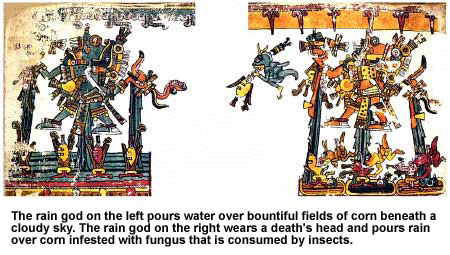
 |
John Pohl's MESOAMERICA |
||
|
ANCIENT BOOKS: Borgia Group Codices
While thematic guides like Codex Telleriano Remensis and Codex Rios have proven useful for understanding the calculation of the principal feast days, the patron gods of one’s birth date, and so forth, scholars also depend on many other written sources to interpret the divisions of the sacred calendar. The famous German scholar Eduard Seler discovered a text in a very early account called the Historia Mexicana por sus Pinturas that seemed to explain pages 27 and 28. The pages depict different manifestations of the rain god Tlaloc pouring water over fields from staffs shaped as serpents and small vessels. Each field is shown to be either bountiful in crops or suffering from some disease, drought, insects or rodents. "The rain god lived in four chambers, and that there was a great court in the middle where stood four great casks of water. The water in one of these was said to be very good, and the rain came from it at the right time, when the grain and the corn were growing. In the next the water was said to be bad, and the rain which came from it produced fungous growth in the corn, which turned black. It came from the third when it rained and froze; from the fourth, when it rained and no corn came up or when it came up and dried. This rain god, in order to produce rain, was said to have created many helpers… (called Tlaloque), who lived in the four chambers and carried sticks in their hands and jars into which they drew water from great casks, and if the god commanded them to water some strip of land they took their jars and sticks and poured out water as they had been commanded; if there was a flash of lightening it was from something they had in the water or from the cracking of the jar." (Seler 1904:267-268) |
|||
|
Text links to all pages at this site are available at the FAMSI INDEX |
|||
